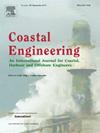多孔人工鱼礁波浪转换的参数化模拟
IF 4.5
2区 工程技术
Q1 ENGINEERING, CIVIL
引用次数: 0
摘要
多孔人工鱼礁可以减少近岸波浪的传播,提供基于自然的海岸保护。现有的预测通过多孔人工鱼礁的波浪传输的方法依赖于经验公式来描述体波传输,这些体波传输汇总了负责波衰减的不同水动力过程的作用,包括破碎力和阻力的波耗散以及来自鱼礁的波反射。由于缺乏能够准确参数化这些不同水动力过程的综合预测模型,因此在应用于不同的礁体设计和水动力条件时,人工礁对波浪衰减的预测增加了不确定性。为了解决这一差距,本研究开发了一种参数化相位平均建模方法,通过参数化破碎、阻力耗散和波浪反射对波浪能量通量变化的单个贡献,来预测多孔人工礁的波浪转换过程。在不透水礁上(即在没有礁内部阻力的情况下)的波浪变换观测最初用于评估破断耗散公式,而在三种不同的立方型多孔礁上的非破断波情况用于评估描述礁的阻力诱导耗散的公式。进一步证明,该模型可以准确预测多孔礁在大水深范围、规则波和不规则波条件下同时发生破碎和阻力耗散的波浪变换。最后,应用验证模型研究了不同设计参数(包括水深、波浪条件和礁体几何参数)对各种礁体应用场景下波浪传输和能量平衡的影响。本研究开发的预测框架旨在适用于其他多孔珊瑚礁,当几何相关参数可以稳健地定义时,可以将其纳入相平均波浪模型,以预测波浪在多孔珊瑚礁结构中的转换过程,以帮助设计模块化人工珊瑚礁,用于基于自然的海岸保护。本文章由计算机程序翻译,如有差异,请以英文原文为准。
Parametric modelling of wave transformation across porous artificial reefs
Porous artificial reefs can provide nature-based coastal protection by reducing nearshore wave transmission. Existing approaches to predict wave transmission across porous artificial reefs have relied on empirical formulations to describe bulk wave transmission that aggregate the role of different hydrodynamic processes responsible for wave attenuation, including wave dissipation by both breaking and drag forces and wave reflection from the reef. The lack of an integrated predictive model capable of accurately parameterizing these different hydrodynamic processes adds uncertainty to predictions of wave attenuation by artificial reefs when applied to different reef designs and hydrodynamic conditions. To address this gap, this study develops a parametric phase-averaged modelling approach to predict wave transformation processes across porous artificial reefs by parameterizing the individual contributions of breaking, drag dissipation and wave reflection to the changes of wave energy fluxes across a reef. Observations of wave transformation over an impermeable reef (i.e., in the absence of interior-reef drag forces) were initially used to assess breaking dissipation formulations, while non-breaking wave cases across three different cubic-type porous reefs were used to assess formulations to describe drag-induced dissipation by the reef. The model was further shown to accurately predict wave transformation for porous reef cases where both breaking and drag dissipation simultaneously occurred, for conditions that spanned a wide range of water depths, regular and irregular wave conditions. The validated model was finally applied to investigate the influence of different design parameters, including water depths, wave conditions and reef geometry parameters, on wave transmission and energy balances across a broad range of reef application scenarios. The predictive framework developed in this study is designed to be applicable to other porous reefs when geometry-dependent parameters can be robustly defined, which can be incorporated into phase-averaged wave models to predict wave transformation processes across porous reef structures to aid the design of modular artificial reefs for nature-based coastal protection.
求助全文
通过发布文献求助,成功后即可免费获取论文全文。
去求助
来源期刊

Coastal Engineering
工程技术-工程:大洋
CiteScore
9.20
自引率
13.60%
发文量
0
审稿时长
3.5 months
期刊介绍:
Coastal Engineering is an international medium for coastal engineers and scientists. Combining practical applications with modern technological and scientific approaches, such as mathematical and numerical modelling, laboratory and field observations and experiments, it publishes fundamental studies as well as case studies on the following aspects of coastal, harbour and offshore engineering: waves, currents and sediment transport; coastal, estuarine and offshore morphology; technical and functional design of coastal and harbour structures; morphological and environmental impact of coastal, harbour and offshore structures.
 求助内容:
求助内容: 应助结果提醒方式:
应助结果提醒方式:


